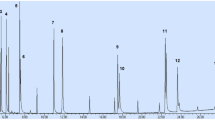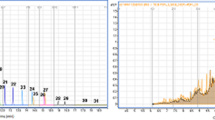Abstract
In the present study, a novel and reliable analytical method was developed and validated for the simultaneous determination of 1,3,5-tris(2,3-dibromopropyl)-1,3,5-triazine-2,4,6(1H,3H,5H)-trione (TDBP-TAZTO) and 2,4,6-tris(2,4,6-tribromophenoxy)-1,3,5-triazine (TTBP-TAZ) in environmental samples using high-performance liquid chromatography coupled to a tandem mass spectrometer. Firstly, for optimization of the liquid chromatography separation, mobile phases, oven temperatures, modifiers, and buffers were varied. Afterwards, the extraction efficiency of sediment and fish samples was tested with different techniques (pressurized liquid, solid-liquid, ultrasound-assisted, and Soxhlet extraction). Additionally, cleanup using modified multilayer silica gel (sediment) and gel permeation chromatography as well as Florisil® columns (fish) with several solvent mixtures were performed. The best results were obtained with the pressurized liquid extraction (optimal conditions: extraction solvent 100% toluene, extraction time 20 min, cycles two, extraction temperature 100 °C, and flushing volume 60%) compared to other solvent extraction methods. On the basis of this optimized analytical procedure, the method was validated with satisfactory values of correlation coefficient (R2) between 0.998 and 0.999 for both matrices in the calibration range of 2.0–502.0 μg kg−1 for TDBP-TAZTO and 16.6–770.6 μg kg−1 for TTBP-TAZ in sediment samples as well as 4.8–303.5 μg kg−1 and 47.4–742.5 μg kg−1 in fish samples (bream), respectively. Mean recoveries (n = 5) were calculated for both analytes with spiked matrices at one concentration level (100 μg kg−1) between 98 and 114% with intra-day relative standard deviations less than 11%. The inter-day precision (n = 15) was also acceptable for both compounds < 11%. It was found that the limit of detection and limit of quantification were in the range of 0.4–1.3 μg kg−1 for TDBP-TAZTO and 10–28 μg kg−1 for TTBP-TAZ in surface sediment samples and 7–25 μg kg−1 and 22–80 μg kg−1 in fish samples (bream), respectively. The results indicated that these analytical methods could provide reliable and efficient approaches for quantification of TDBP-TAZTO and TTBP-TAZ in sediment and fish samples.

Graphical abstract



Similar content being viewed by others
References
Fatunsin OT, Oluseyi TO, Drage D, Abdallah MA-E, Turner A, Harrad S. Children’s exposure to hazardous brominated flame retardants in plastic toys. Sci Total Environ. 2020;720:137623. https://doi.org/10.1016/j.scitotenv.2020.137623 .
Gebbink WA, van der Lee MK, Peters RJB, Traag WA, ten Dam G, Hoogenboom RLAP, et al. Brominated flame retardants in animal derived foods in the Netherlands between 2009 and 2014. Chemosphere. 2019;234:171–8. https://doi.org/10.1016/j.chemosphere.2019.06.046 .
Gewurtz SB, Guerra P, Kim MG, Jones F, Challen Urbanic J, Teslic S, et al. Wastewater treatment lagoons: local pathways of perfluoroalkyl acids and brominated flame retardants to the Arctic environment. Environ Sci Technol. 2020. https://doi.org/10.1021/acs.est.9b06902 .
Harrad S, Drage DS, Sharkey M, Berresheim H. Brominated flame retardants and perfluoroalkyl substances in landfill leachate from Ireland. Sci Total Environ. 2019;695:133810. https://doi.org/10.1016/j.scitotenv.2019.133810 .
Harrad S, Drage DS, Sharkey M, Berresheim H. Perfluoroalkyl substances and brominated flame retardants in landfill-related air, soil, and groundwater from Ireland. Sci Total Environ. 2020;705:135834. https://doi.org/10.1016/j.scitotenv.2019.135834 .
Meng Y, Zhang H, Qiu Y, Du X, Niu D, Lu Z, et al. Seasonal distribution, gas–particle partitioning and inhalation exposure of brominated flame retardants (BFRs) in gas and particle phases. Environ Sci Eur. 2019. https://doi.org/10.1186/s12302-019-0257-2 .
Wemken N, Drage DS, Abdallah MA-E, Harrad S, Coggins MA. Concentrations of brominated flame retardants in indoor air and dust from Ireland reveal elevated exposure to decabromodiphenyl ethane. Environ Sci Technol. 2019;53:9826–36. https://doi.org/10.1021/acs.est.9b02059 .
Ballesteros-Gómez A, Ballesteros J, Ortiz X, Jonker W, Helmus R, Jobst KJ, et al. Identification of novel brominated compounds in flame retarded plastics containing TBBPA by combining isotope pattern and mass defect cluster analysis. Environ Sci Technol. 2017;51:1518–26. https://doi.org/10.1021/acs.est.6b03294 .
Ballesteros-Gómez A, de Boer J, Leonards PEG. A novel brominated triazine-based flame retardant (TTBP-TAZ) in plastic consumer products and indoor dust. Environ Sci Technol. 2014;48:4468–74. https://doi.org/10.1021/es4057032 .
Feng J, Wang Y, Ruan T, Qu G, Jiang G. Simultaneous determination of hexabromocyclododecanes and tris (2,3-dibromopropyl) isocyanurate using LC-APCI-MS/MS. Talanta. 2010;82:1929–34. https://doi.org/10.1016/j.talanta.2010.08.014 .
Li F, Jiang H-Q, Li X-M, Zhang S-S. 2,4,6-Tris(2,4,6-tribromophenoxy)-1,3,5-triazine. Acta Crystallogr Sect E: Struct Rep Online. 2006;62:o3303–4. https://doi.org/10.1107/S1600536806026134 .
Ling S, Huang K, Tariq M, Wang Y, Chen X, Zhang W, et al. Photodegradation of novel brominated flame retardants (NBFRs) in a liquid system: kinetics and photoproducts. Chem Eng J. 2019;362:938–46. https://doi.org/10.1016/j.cej.2019.01.103 .
Liu A, Qu G, Zhang C, Gao Y, Shi J, Du Y, et al. Identification of two novel brominated contaminants in water samples by ultra-high performance liquid chromatography-Orbitrap Fusion Tribrid mass spectrometer. J Chromatogr A. 2015;1377:92–9. https://doi.org/10.1016/j.chroma.2014.12.038 .
Lörchner D, Kraus W, Köppen R. Photodegradation of the novel brominated flame retardant 2,4,6-Tris-(2,4,6-tribromophenoxy)-1,3,5-triazine in solvent system: kinetics, photolysis products and pathway. Chemosphere. 2019;229:77–85. https://doi.org/10.1016/j.chemosphere.2019.04.184 .
Lörchner D, Kroh LW, Köppen R. First insights into electrochemical transformations of two triazine-based brominated flame retardants in model systems. Anal Methods. 2018;10:5164–70. https://doi.org/10.1039/C8AY01968A .
Lörchner D, Kroh LW, Köppen R. 1,3,5-Tris-(2,3-dibromopropyl)-1,3,5-triazine-2,4,6-trione: kinetic studies and phototransformation products. Environ Sci Pollut Res Int. 2019;26:15838–46. https://doi.org/10.1007/s11356-019-04815-w .
Xiong P, Yan X, Zhu Q, Qu G, Shi J, Liao C, et al. A review of environmental occurrence, fate, and toxicity of novel brominated flame retardants. Environ Sci Technol. 2019;53:13551–69. https://doi.org/10.1021/acs.est.9b03159 .
Zuiderveen EAR, Slootweg JC, de Boer J. Novel brominated flame retardants - a review of their occurrence in indoor air, dust, consumer goods and food. Chemosphere. 2020;255:126816. https://doi.org/10.1016/j.chemosphere.2020.126816 .
EFSA. Scientific opinion on emerging and novel brominated flame retardants (BFRs) in food. EFSA J. 2012;10:2908. https://doi.org/10.2903/j.efsa.2012.2908 .
Ruan T, Wang Y, Wang C, Wang P, Fu J, Yin Y, et al. Identification and evaluation of a novel heterocyclic brominated flame retardant tris(2,3-dibromopropyl) isocyanurate in environmental matrices near a manufacturing plant in southern China. Environ Sci Technol. 2009;43:3080–6. https://doi.org/10.1021/es803397x .
Zhang Y, Zheng M, Wang L, Lou Y, Shi L, Ke R, et al. High level of tris-(2,3-dibromopropyl) isocyanurate (TBC) and hexabromocyclododecanes (HBCDs) in sediments from the intertidal zone of New River Estuary-a polluted and degraded wetland. Mar Pollut Bull. 2018;130:287–92. https://doi.org/10.1016/j.marpolbul.2018.03.045 .
Zhu N, Li A, Wang T, Wang P, Qu G, Ruan T, et al. Tris(2,3-dibromopropyl) isocyanurate, hexabromocyclododecanes, and polybrominated diphenyl ethers in mollusks from Chinese Bohai Sea. Environ Sci Technol. 2012;46:7174–81. https://doi.org/10.1021/es300776f .
Wang L, Zhang M, Lou Y, Ke R, Zheng M. Levels and distribution of tris-(2,3-dibromopropyl) isocyanurate and hexabromocyclododecanes in surface sediments from the Yellow River Delta wetland of China. Mar Pollut Bull. 2017;114:577–82. https://doi.org/10.1016/j.marpolbul.2016.09.019 .
Wang L, Zhao Q, Zhao Y, Lou Y, Zheng M, Yu Y, et al. Determination of heterocyclic brominated flame retardants tris-(2, 3-dibromopropyl) isocyanurate and hexabromocyclododecane in sediment from Jiaozhou Bay wetland. Mar Pollut Bull. 2016;113:509–12. https://doi.org/10.1016/j.marpolbul.2016.08.013 .
Guo J, Stubbings WA, Romanak K, Nguyen LV, Jantunen L, Melymuk L, et al. Alternative flame retardant, 2,4,6-tris(2,4,6-tribromophenoxy)-1,3,5-triazine, in an E-waste recycling facility and house dust in North America. Environ Sci Technol. 2018;52:3599–607. https://doi.org/10.1021/acs.est.7b06139 .
Commission decision of 12 August 2002. Implementing Council Directive 96/23/EC concerning the performance of analytical methods and the interpretation of results (2002/657/EC).
Acknowledgments
We thank Dr. K. Fisch for using the sediment samples from different locations in the Baltic Sea. We would like to take this opportunity to thank Mr. Steven Behm and the Nierdersächsisches Landesamt für Verbraucherschutz und Lebensmittelsicherheit (Lower Saxony state office for consumer protection and food safety) for providing the fish samples from the river Dahme and from the North Atlantic, respectively.
Author information
Authors and Affiliations
Corresponding author
Ethics declarations
Conflict of interest
The authors declare that they have no conflicts of interest.
Additional information
Publisher’s note
Springer Nature remains neutral with regard to jurisdictional claims in published maps and institutional affiliations.
Supplementary information
ESM 1
(PDF 482 kb).
Rights and permissions
About this article
Cite this article
Lörchner, D., Tang, D., Mauch, T. et al. Development and validation of a liquid chromatography-mass spectrometry method for simultaneous analysis of triazine-based brominated flame retardants in environmental samples. Anal Bioanal Chem 413, 987–998 (2021). https://doi.org/10.1007/s00216-020-03057-x
Received:
Revised:
Accepted:
Published:
Issue Date:
DOI: https://doi.org/10.1007/s00216-020-03057-x




